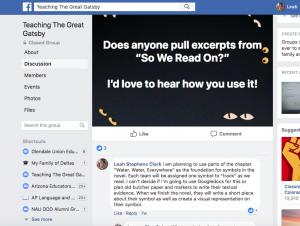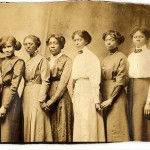I joined Facebook in 2002 when you had to have a college email address to sign up for the social media site. Each day I checked my account in anticipation of the new friend requests I received.
Over the years, the site as evolved into a way to connect with friends and family around the world to keep in touch. And while the site has experienced scrutiny over the last few weeks for its security breaches, I am still an avid user. Not only does it show the latest wedding announcement, baby pictures and political posts, but Facebook has become an online Professional Development Committee.
Wait. What? Did she just say PLC? Yes, I did. I joined a group last summer for AP Language and Composition teachers. While I am not an AP Lang teacher, I do teach Pre AP sophomores whom I prepare for AP Language and Literature their junior and senior years. I attended a Pre AP summer workshop and met amazing teachers from around the country who raved about their Facebook group. Little did I know, I would be joining a group of nearly 2,000 educators across the country that would help me navigate this new world.
At first, I just lurked on the group page, reading posts and browsing the resources. After about 6 months, I felt brave enough to reply to a post about teaching a unit about our criminal justice system. Much to my surprise, people immediately wanted my materials.
A couple months later, I mustered up the courage and posted a question. “How do you assess annotations? I need to more effectively hold my students accountable on both short pieces and novels. Do you use a rubric? I feel like my kids just scribble or randomly highlight to make it look like they are annotating, but clearly they aren’t doing anything effective. HELP!”
Six experienced teachers replied with helpful tips, hints, models, and rubrics. For some reason, I felt more comfortable asking total strangers online than asking my fellow PLC members at my school. This perceived anonymity of my name and small profile picture on the screen of other teachers felt like a more comfortable place to be vulnerable to put myself out there and ask questions than facing colleagues who know me.
I also joined a group of about 325 teachers who love teaching The Great Gatsby as much as I do. This group of fellow Gatsby fanatics has been instrumental in providing resources and materials for teaching the greatest American novel of all time (or at least in my opinion).
One teacher posted an amazing poetry lesson that requires students to closely read a page and black out nearly the whole page only leaving certain words and phrases visible to create a poem. I immediately replied and asked for the specifics and materials. She quickly sent them over, and I am looking forward to using this lesson at the end of the novel.
I read a post last week about a particular scene in Gatsby that I happened to have taught the day before. After reading a fabulous thread of ideas, comments, and analysis of the scene, I had my students revisit Fitzgerald’s words and discuss his use of symbolism and word choice. My students’ discussion was thoughtful and engaging and all thanks to a social media.

By creating online learning communities, we are collaborating with individuals we may not have the opportunity to work with on our campuses. The resources, ideas, materials, (and fellow commiserating comments) have opened up new ways of thinking, teaching, and learning for me and my students. Even with the best on campus learning communities, we can all benefit from joining a group who teaches similar content across the country. By hitting the like button, we are helping our students and our students.
Are you currently using any online groups, social media sites, forums, or blogs to engage in professional development? If so, feel free to comment below.









Comments 3
Spot on. It’s so true that it is used as time off and time on. Danielle Brown once called Twitter the world’s largest PLN and it’s true. Effective use of social media, much like effective conversation can lead to unexpected growth and reflection— even when you’re in the lobby getting your oil changed.
Yes! I love to hop on to social media and learn something new I can use in my practice.
Great post and I agree 100%. I actually use Facebook exclusively for professional work: connecting with others, reading/sharing articles about education, and promoting blogs from the Stories from School blog team. I have found it very helpful for collaboration! I’m so glad you’ve written this blog to shine a light on Facebook as a PLC tool!